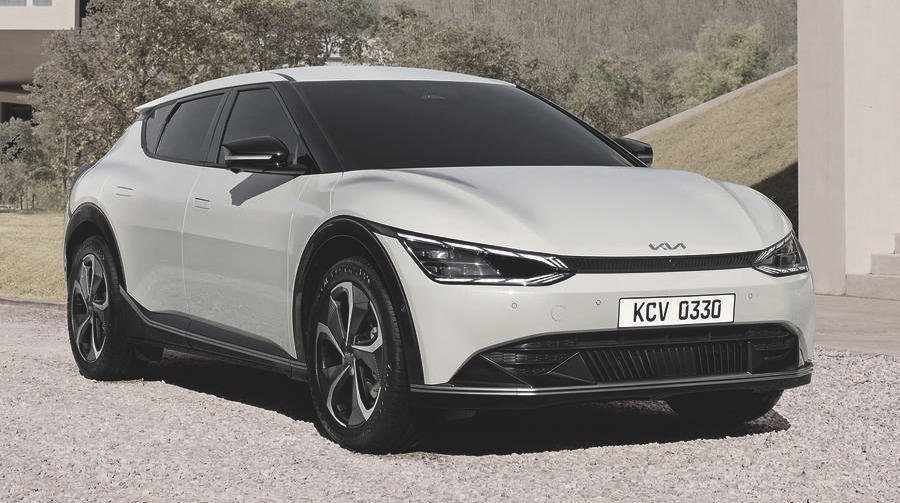Kia says it is taking "electric performance to another level" with the GT-badged hot version of its new EV6 electric flagship, which will top out a range comprising two- and four-wheel-drive variants with a choice of different battery sizes.
The dual-motor EV6 GT sends 577bhp and 546lb ft to both axles, and is expected to get from 0-62mph in just 3.5 seconds and reach a top speed of 162mph, making it not only the quickest Kia yet built, but also more powerful and faster than the Porsche Taycan 4S.
Lower down the range, the EV6 is available in either rear-wheel-drive form with a 77.4kWh battery giving 316 miles of range, or with four-wheel-drive and a smaller 58.0kWh power pack, which will likely give a range of around 250 miles. The two-wheel-drive version uses a 226bhp motor on the rear axle and is capable of 0-62mph in 6.2 seconds, while the non-GT four-wheel-drive version ups power to 321bhp and packs 446lb ft for a 0-62mph time of 5.2 seconds.
The EV6's powertrain line-up can be expected to be adopted by the closely related Hyundai Ioniq 6, which will arrive later this year as a performance-focused electric saloon to rival the Mercedes-Benz EQS and Audi E-tron GT.
The EV6's E-GMP platform, which it shares with the recently revealed Hyundai Ioniq 5, is equipped with 800V charging architecture. This will allow charging from 0-80% capacity in as little as 18 minutes, depending on battery size, and can take on 62 miles of range in less than four and a half minutes. The EV6 is also equipped with a 'vehicle-to-load' function which can supply up to 3.6kW of power to external devices - including other EVs - and, with more than 35% charge, has a towing capacity of 1600kg.
Range-maximising features include an innovative heat pump which "scavenges waste heat from the car's coolant system" to ensure that, at temperatures of -7degC, the EV6 offers 80% of the range it would at 25degC. Adjustable regenerative braking is fitted across the range, too, with paddle shifters behind the steering wheel allowing drivers to choose from six different modes.
Kia has also given new details of the EV6's headline tech features, including an augmented reality head-up display which shows ADAS alerts, speed data and turn-by-turn navigation instructions. The latest iteration of Kia's connectivity package features, too, with inbuilt EV-specific functions, as does a raft of advanced driver safety aids.
The South Korean-built EV6 will be available in the UK from October 2021, with prices starting at £40,895 for the EV6. The EV6 GT-Line starts at £43,895, while the top-of-the-line GT will come with a significant premium, of £58,295. A pre-reservation process opens from today.
As Kia's first bespoke production electric car, the EV6 pairs a radical new design with unprecedented levels of performance for the brand. It will also spearhead a wave of new-era electric cars from Kia.
Each will be badged EV followed by a number corresponding to its size. So the EV6 crossover is a mid-sized car, which leaves room below for compact SUVs, hatchbacks and saloons, and for larger SUVs at the top of the range. Kia will launch a further six bespoke EVs by 2026, with the model nomenclature ranging from EV1 to EV9.
The new model's design pioneers a new 'Opposites United' styling ethos that leans on "contrasting combinations of sharp stylistic elements and sculptural shapes". Future models will take similarly dramatic design cues, with key tenets of the new philosophy including 'daring' colour schemes, simple lines and "bold, everchanging surfaces".
The influence of Kia's 2019 Imagine concept is clear. Although the overall silhouette has evolved to give a lower, less overtly SUV-oriented stance, there's a new interpretation of Kia's trademark 'tiger nose' grille and an obvious emphasis on aerodynamic optimisation.
The distinctive headlights and wraparound light bar at the rear will display a new sequential light pattern.
The flat floor of the E-GMP platform and a new minimalist interior design ethos mean the EV6's cabin is more spacious than those of Kia's existing EVs. A sloping dashboard and slim, lightweight seat designs are used to minimise incursion into the occupants' space. As with its Hyundai sibling, the EV6 uses recycled plastics throughout the interior.
The Imagine concept's 21-screen dashboard display has not been carried over. The dashboard is dominated by an expansive and "immersive" one-piece curved display in place of a conventional infotainment screen and separate gauge cluster, while a haptic control panel is used for operating the climate control.

